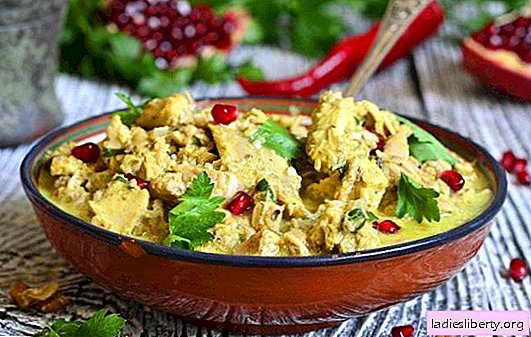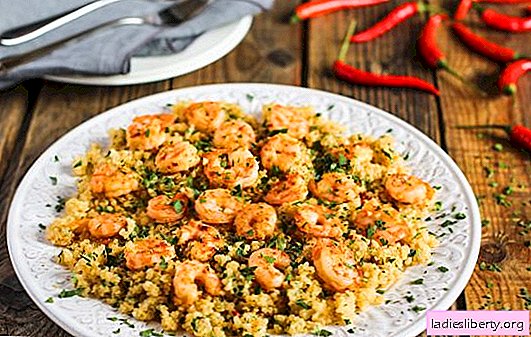
Satsivi has a very long history, so it is a matter of national pride in Georgian cuisine, and the basic composition of its components cannot be
to interpret freely so as not to offend the proud Caucasian people. But in the technology of cooking traditional Satsivi, there are also moments where
can improvise.
If you once had a chance to try a meal at dinner in one of the Georgian families living in the Caucasus, or appreciate the skill of the present
Georgian cook, please share the secret of cooking. There are not so many “right” Satsivi recipes on the net written in Russian, and familiar housewives from Georgia say that Satsivi is like borsch, it is prepared differently in every family.
We’ll try to catch the main notes of bright and so different Georgian cuisine in order to determine the boundary between unshakable traditions and
opportunities for improvisation.
Georgian Chicken Satsivi - Basic Technological Principles
Satsivi is a sauce and, at the same time, the name of the dish, which is often prepared from poultry: chicken or turkey. There are options for satsivi from
fish. This is a cold dish, without which no holiday can do in Georgia, especially - New Year and Christmas, like New Year in Russian
not complete without jellied meat. Satsivi, of course, is not jelly, but a rich meat or fish broth, as you know, has the property to turn
into a jelly-like mass.
You can, of course, eat chicken with peanut sauce and hot, but then it is just ordinary chicken with peanut sauce. Meat with sauce
withstand that it absorbs the aroma that distinguishes Satsivi from boiled chicken with gravy. The conversion process lasts 7-8 hours.
Walnuts, garlic, cilantro (ground coriander), Imereti saffron, uzo suneli (fenugreek) - these are mandatory components of satsivi. By the way
they are very often used in all dishes of Georgian cuisine. A few words about these ingredients:
Walnut - only this nut is used for satsivi, and no other. Walnut oil can be added, but it will not completely replace
ground kernels giving a paste-like consistency. There should be a lot of nuts, not less than 1/3 part in relation to the mass of meat.
With garlic, everything is clear: peel and chop. The amount depends on taste preferences. Take note: the characteristic smell and
the aftertaste of garlic is lost when combined with fresh cilantro.
If you use fresh cilantro, then juice must be squeezed out of it: the sauce should have a characteristic nutty color. Of course, nothing is wrong
it will happen if small pieces of greens are noticeable in the sauce, but this moment refers to the issue of culinary aesthetics.
Utsho suneli: do not confuse the seasoning of suneli hops, consisting of a set of spices! Uso Suneli has many other names that are only
point to its wide distribution and special role in the culinary of all nations of the world: shambhala, chaman, curry (mixed with turmeric),
fengurek. You will look for seasoning in the spice department - remember these names. We have this herb called fenugreek, and all of it many times
seen: blue or lilac flowers, also called clover. Dried and ground seeds are used as spices.
You can also use suneli hops for cooking satsivi, but keep in mind that you will get a completely different taste.
Marigolds - Imereti saffron. If someone is surprised - do not be surprised! These are those very bright yellow or orange flowers, but for food
only ground petals of basic varieties are used: the brighter - the better. By the way, if marigolds are planted in tomato aisles,
potatoes, strawberries, you can, in addition, not only get beauty and a very pleasant seasoning, but also save your crop from
pests. Another important point: if you have never been familiar with this spice, then personally grown flowers will save you from cheating
sellers of spices who can sell turmeric instead of marigold powder (also a useful spice, but another and cheap!).
If you pay attention to the chemical composition of marigolds, fenugreek and other traditional spices used in Georgian cuisine, you will learn
the main secret of Caucasian health and longevity. In the culinary of this people everything is thought out to the smallest detail: each, plain-looking, weed
has a deep meaning. Therefore, the flavors of Caucasian cuisine are so fascinating.
Back to the sauce. The rest is a set of ingredients - like all sauces. Just never add in satsivi adjika, potato starch and
Tomatoes This is another dish. Now about the meat for Satsivi, and move on to recipes that differ from each other only in the set for the sauce.
It is not true that satsivi is cooked correctly only from turkey. If in the dispute about what happened before, an egg or a chicken, some
intrigue, then Satsivi in Georgia appeared much earlier than turkeys. Pheasant dishes are often prepared, but this bird is already a luxury, but the chicken
ideal for the price, availability, ease of processing and the neutral taste of meat. But the chicken should be good, homemade, with yellow
fat, if not already young - even better.
The detailed technology for the preparation of chicken satsivi in Georgian is in the first recipe, because the main principles of cooking are almost not
change, with the exception of different methods of pre-preparation of the bird, and with recipes for the sauce you can even improvise, because
the basic meaning is already clear.
1. Georgian Chicken Satsivi - The First Way
Ingredients:
Medium chicken, domestic - 1 carcass (2.0 -2.2 kg)
For broth:
Onions, black pepper, bay leaf, parsley root, salt
Onions 350 - 400 g (onion)
Nuts 750-800 g (net)
Cilantro 75 g
Garlic 60-70 g
Saffron Imereti (marigolds)
Vinegar
Coriander
Red pepper
Vegetable oil
Cooking Technology:
Dip the prepared chicken carcass into boiling water. Cook, as usual, until the flesh begins to separate from the bone. Do not forget to shoot
the foam. At the end of cooking, add spices, roots and salt. Transfer the chicken to the dish. Optionally, you can separate the meat from the bone when the chicken
cool down. Strain the broth.
Cilantro, nuts and garlic twice pass through a fine grid of a meat grinder.
Grind the onions separately in mashed potatoes. You can do this with a blender. Pour oil into a preheated pan, put onion puree and
Passer to remove bitterness, only until transparent. If it starts to burn, add a little broth. Shift the stew
in a saucepan in which the sauce will be prepared, add nut paste, broth. It is important to guess the consistency of the sauce: add this
the amount of broth so that after hardening the sauce looks like thick sour cream. Mix thoroughly, removing lumps, add spices:
ground coriander, a little red pepper, salt.
Place the pot on low heat: the sauce should simmer with occasional stirring. Make sure that the thick nut mass does not burn,
sinking to the bottom of the pan.
When the sauce begins to boil, add wine vinegar in such an amount that its acid is clearly visible. Put slices in saucepan with sauce
chicken, and lightly warm. Remove the pan from the stove. Fold the satsivi into tureens, preferably covered.
2. Georgian Chicken Satsivi - The Second Way
Ingredients - according to the recipe No. 1
Cooking:
The whole cooking technology is absolutely similar to the first method, except for the preparation of meat. Cut boiled chicken into portions
pieces, fry in a pan or in the oven. Put the fried meat in a tureen and pour in peanut sauce.
When frying, meat is removed from the meat, and after soaking in the sauce, the taste of satsivi becomes more saturated.
3. Georgian Chicken Satsivi with Egg Yolks
It is not known how and when a recipe for Dutch sauce got in Georgia, which is thickened with egg yolk, but in some Georgian
Families use this technique to make Satsivi.
Ingredients:
Wings, legs - by the number of servings
Vegetable oil (or margarine) - for frying
Garlic, ground black pepper
Chicken bouillon:
Poultry meat;
Water;
Bulb;
Spicy roots;
Pepper (peas);
Bay leaf;
Salt;
Sauce ingredients - according to the recipe No. 1, as well as 3 yolks
Order of preparation:
If there is a ready-made meat broth - use it for satsivi; if not, cook as usual. Try to use chicken backs, necks,
and the legs, wings and breast, grate with a mixture of ground garlic and pepper, fry until golden brown.
Cook the walnut paste as described in the first recipe, add the yolks to it, rub well and add warm broth. Shuffle up
homogeneous consistency and slowly warm on the stove until thickened. Put the meat fried until cooked in the prepared portion
dishes, pour sauce, cover. Serve after cooling and insisting, with gomi (cornmeal porridge).
4. Georgian Chicken Satsivi with Pomegranate
Let's face it: in our area wine vinegar, in home cooking, housewives do not often use; It is not cheap. If Satsivi is planned, and
the desired ingredient remained on the shelf in the store, what should I do? Do not worry, everything is fixable: lemons, pomegranates or fruits with sour
tasteful. Just do not forget about the nutty color and taste of the dish, and that tomatoes in Satsivi are "bad manners."
Ingredients:
Chicken thighs, wings 2 kg
Bouillon 1.5 - 2.0 L
Passion Butter
Flour
Nutmeg
Clove
White pepper
The composition of the products for the sauce - according to the recipe number 1
Pomegranate juice (fresh) - instead of wine vinegar
Cooking:
In flour (70-100 g) add ground nutmeg and cloves, white pepper. Roll boiled meat in flour mixture. Preheat the pan, put in
her butter, chopped onions, and fry the wings and hips. Transfer meat to portioned dishes. Passerute in the same pan.
finely chopped onions until transparent, and add it to the nut mass, mix well. Add the broth and cook the sauce until tender.
Pour hot satsivi into meat plates. Cover the cooled dish with a film or lids, put in a cold place for insisting.
5. Georgian chicken satsivi with dried cilantro and chicken fat
Ingredients:
Boiled chicken
Chicken fat
Bow
For the sauce:
Dried cilantro, red pepper, coriander, ground nuts, garlic, salt, corn and wheat flour;
Wine vinegar;
Saturated broth
Cooking:
Combine ground nuts, garlic and dry spices, add flour. Stir the dry mixture.
Chop the onions. Melt the chopped fat in a pan, sauté the onion until soft. Combine with cooked nut mixture,
mix, add the broth.
When using flour to make satsivi broth, you need to add more so that the sauce does not turn out too thick after solidification.
Stew the resulting mixture over low heat. 3-4 minutes after boiling the sauce, add vinegar, pour the meat laid out in the tureen.
6. Georgian Chicken Satsivi - Adjarian Cuisine
Ingredients:
Chicken 1.8 - 2 kg
Onion 250 g
Chicken broth 700 ml
Oil (sunflower or corn) 120 ml
Nuts 800 g
Garlic 50 g
Suneli hops
Imereti Saffron
Salt
Lemons 2 pcs.
Celery, parsley, cilantro (leaves)
Cooking method:
Cook the broth by placing the carcass in cold water. Separate the flesh of the cooked bird from the bones. Strain the broth by removing the spicy additives.
Make the sauce:
Sauté the nuts in a preheated pan, add garlic, butter, suneli hops and Imereti saffron. Punch the mass with a blender by adding
spices. Fry finely chopped onions, combine with nut mass, grind again with a blender, adjusting the density of the sauce with broth.
Pour the mass into a saucepan with meat and simmer for 40-50 minutes. The meat is soaked in sauce, it will become very soft and tender. Add juice at the end of the stew.
and zest of lemons.
Georgian Chicken Satsivi - Useful Tips
To prepare satsivi, you need to rub the onion on a fine grater. Use white onion - it is less "evil", or onion previously
hold in water to remove bitterness and not cry when rubbing.
Satsivi requires at least 1/3 of the nuts in relation to the weight of the chicken.
Using fresh cilantro for satsivi, make sure that the sauce does not turn green. Just in case, just squeeze the juice out of spicy herbs.
Note that more juice is found in cilantro stems; leaves can be used to decorate dishes.











